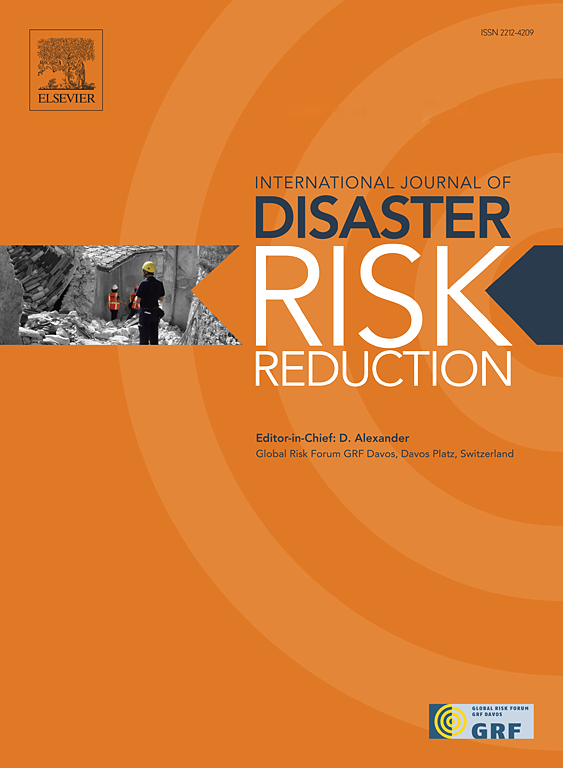从警报到行动:西班牙大加那利岛ES-Alert演习期间公民对手机广播警报反应的社会延迟
IF 4.5
1区 地球科学
Q1 GEOSCIENCES, MULTIDISCIPLINARY
International journal of disaster risk reduction
Pub Date : 2025-09-02
DOI:10.1016/j.ijdrr.2025.105794
引用次数: 0
摘要
基于小区广播技术的公共警报系统是应急管理的重要工具,但其有效性不仅取决于向设备传输信息的技术速度(技术延迟),还取决于公民在收到信息后执行建议的自我保护行动所需的时间(社会延迟)。手机广播与所谓的机会之窗密切相关,而机会之窗是风险管理的关键因素。这项研究在2024年9月在西班牙大加那利岛(Gran Canaria)进行的ES-Alert演习期间对西班牙的社会潜伏期进行了开创性的评估,参与人数超过5万人。通过分析与访问与警报一起发送的数字调查相关的时间戳,确定了公民的反应时间。结果表明,超过70%的被试反应时间在10分钟以内,平均反应时间为1分12秒。与技术普及率较低的农村地区相比,城市和旅游城市的反应明显更快。此外,91.4%的参与者对该系统进行了正面评价。限制包括~ 6%的响应率和缺少设备级地理坐标;地点仅在直辖市一级自行报告。该研究强调了将社会潜伏期作为早期预警系统评估的关键指标的重要性,特别是在岛屿和旅游环境中,并建议使用参与性战略来改善风险沟通和加强社区复原力。本文章由计算机程序翻译,如有差异,请以英文原文为准。
From alert to action: Social latency of citizen response to Cell Broadcast warnings during the ES-Alert drill in Gran Canaria (Spain)
Public alert systems based on Cell Broadcast technology are essential tools in emergency management, but their effectiveness depends not only on the technical speed in transmitting the message to the devices (technical latency) but also the time it takes for citizens to execute the recommended self-protection actions after receiving the messages (social latency). Cell broadcast is closely related to the so-called windows of opportunity, which are key factors in risk management. This study presents a pioneering evaluation of social latency in Spain during the ES-Alert drill conducted in September 2024 on the island of Gran Canaria (Spain), with a participation that exceeded 50,000 people. Through the analysis of timestamps associated with access to a digital survey sent with the alert, the citizen reaction times were determined. The results show that more than 70 % of the participants reacted in less than 10 min, with a median response time of 1 min and 12 s. Significantly faster responses were observed in urban and tourist municipalities compared to rural areas with lower technological penetration. Additionally, the system was positively rated by 91.4 % of the participants. Limitations include a ∼6 % response rate and the absence of device-level geocoordinates; location was self-reported at the municipality level only. The study highlights the importance of including social latency as a key metric in the evaluation of early warning systems, especially in insular and tourist contexts, and proposes the use of participatory strategies to improve risk communication and reinforce community resilience.
求助全文
通过发布文献求助,成功后即可免费获取论文全文。
去求助
来源期刊

International journal of disaster risk reduction
GEOSCIENCES, MULTIDISCIPLINARYMETEOROLOGY-METEOROLOGY & ATMOSPHERIC SCIENCES
CiteScore
8.70
自引率
18.00%
发文量
688
审稿时长
79 days
期刊介绍:
The International Journal of Disaster Risk Reduction (IJDRR) is the journal for researchers, policymakers and practitioners across diverse disciplines: earth sciences and their implications; environmental sciences; engineering; urban studies; geography; and the social sciences. IJDRR publishes fundamental and applied research, critical reviews, policy papers and case studies with a particular focus on multi-disciplinary research that aims to reduce the impact of natural, technological, social and intentional disasters. IJDRR stimulates exchange of ideas and knowledge transfer on disaster research, mitigation, adaptation, prevention and risk reduction at all geographical scales: local, national and international.
Key topics:-
-multifaceted disaster and cascading disasters
-the development of disaster risk reduction strategies and techniques
-discussion and development of effective warning and educational systems for risk management at all levels
-disasters associated with climate change
-vulnerability analysis and vulnerability trends
-emerging risks
-resilience against disasters.
The journal particularly encourages papers that approach risk from a multi-disciplinary perspective.
 求助内容:
求助内容: 应助结果提醒方式:
应助结果提醒方式:


